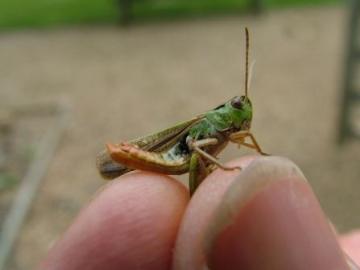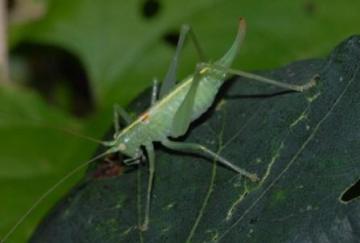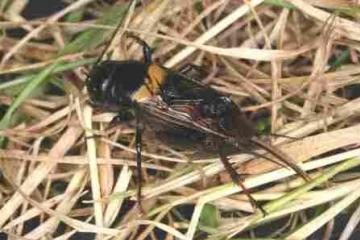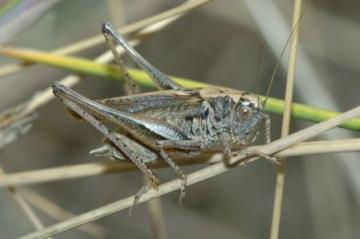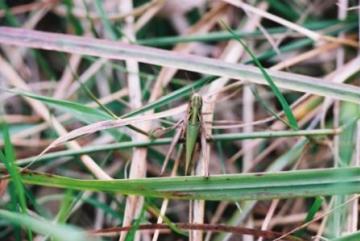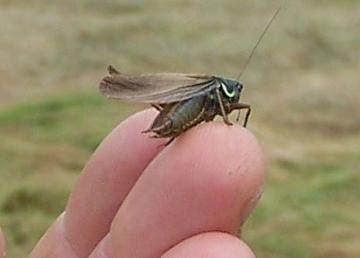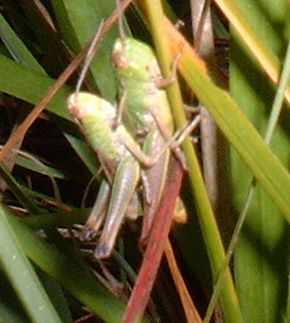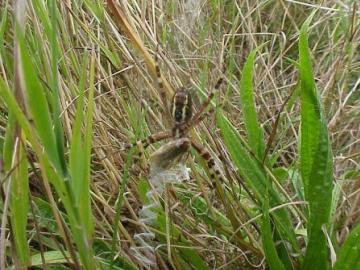Essex Grasshopper Recording
By Dr Tim Gardiner, County Recorder for Orthoptera
Alan Wake was the county recorder for over 20 years and has made a massive contribution to our knowledge of species distributions in Essex. Alan started a survey of the countys Orthoptera in 1980, which yielded a provisional atlas in the mid 1980s (Wake 1984). This atlas included 10km maps for all species recorded and a useful key to adult Orthoptera designed by Roger Payne. Survey work continued throughout the 1980s and early 1990s which ultimately led to the publication €˜Grasshoppers and Crickets of Essex in 1997 (Wake 1997). This publication included 5km distribution maps for all species recorded in the county and was based on approximately 5000 records.
Since the publication of the Grasshoppers of Essex, several thousand records have been collected and the data entered into the recording software, MapMate. The latest distribution maps for individual species can be seen elsewhere on this website. However, new records are always welcome, please send these to Tim Gardiner at tg@writtle.ac.uk.
News
New grasshopper book published 'Hopping back to happiness?'
VDM Verlag have recently published a book titled 'Hopping back to happiness? Conserving grasshoppers on farmland'.
It is currently available to buy on Amazon:
http://www.amazon.co.uk/s/ref=nb_ss?url=search-alias%3Daps&field-keywords=hopping+back+to+happiness ![]()
Book summary
Insects such as grasshoppers and bush-crickets (Orthoptera) are becoming increasingly rare on farmland in eastern England due to the intensification of agriculture since the 1950s. 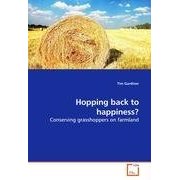 The main aim of the study reported in this book was to examine the influence of these intensive agricultural management regimes, such as mowing and grazing, on grasshoppers and bush-crickets of improved grassland. This study outlines management that is likely to be detrimental and beneficial to grasshopper and bush-cricket populations and includes an assessment of the effects of sward improvement, nitrogen fertiliser input and silage cutting. The book also provides a current assessment of the success of the recently introduced Environmental Stewardship Scheme, which includes habitat management options such as 6 m wide buffer strips around arable fields, that have infrequent mowing and an absence of fertiliser input as their main beneficial features. This analysis should be of interest to professional ecologists, researchers, policy makers, and anyone with a general interest in conserving our declining farmland wildlife.
The main aim of the study reported in this book was to examine the influence of these intensive agricultural management regimes, such as mowing and grazing, on grasshoppers and bush-crickets of improved grassland. This study outlines management that is likely to be detrimental and beneficial to grasshopper and bush-cricket populations and includes an assessment of the effects of sward improvement, nitrogen fertiliser input and silage cutting. The book also provides a current assessment of the success of the recently introduced Environmental Stewardship Scheme, which includes habitat management options such as 6 m wide buffer strips around arable fields, that have infrequent mowing and an absence of fertiliser input as their main beneficial features. This analysis should be of interest to professional ecologists, researchers, policy makers, and anyone with a general interest in conserving our declining farmland wildlife.
Stripe-winged Grasshopper new to Essex Imogen Wilde from the City of London has just found Stenobothrus lineatus (Stripe-winged Grasshopper) on Whitehall Plain, Epping Forest, the grasshopper is a new species to the county (see photo below). Imogen heard several males calling whilst doing vegetation fieldwork on Thursday (9th July) at TQ400938, and then saw a very striking one in her quadrat! The singing activity was centred around a newly-forming ant-hill (lots of bare soil), with Rumex acetosella, Lotus corniculatus and Festuca rubra.
Photo: Imogen Wilde
Organic farm insect study
An indepth survey of four insect orders (which included Orthoptera) on Ashlyns Organic Farm in Bobbingworth has been completed. The surveys took place in the summer of 2008 and 9 Orthoptera species were recorded including the localised Common Groundhopper Tetrix undulata. It seems the absence of chemical fertilisers produces swards that are favourable for Orthoptera (quite short, sparse grassland which is good for grasshoppers due to the warm microclimate). For more info see: http://www.ashlynsorganics.co.uk/document/pdf/InsectsofAshlynsOrganicFarm.pdf ![]()
British Naturalists' Association guide to grasshoppers published on web
I've been working on an introductory guide to grasshoppers and bush-crickets for the BNA for some time now and it has recently been published on their website. The guide provides information on the life cycles and biology of the insects and also gives key tips to distinguishing between grasshoppers and bush-crickets. To download the guide see:
http://www.bna-naturalists.org/educ/ident/orthop.pdf ![]()
Climate change and Orthoptera in Essex: a double edged sword! I gave a talk to the inaugural meeting of the Climate Change Special Interest Group at the Central Science Laboratory in York on 1st October 2008. The meeting was attended by over 100 delegates and was instigated to discuss the potential effects climate change may have on insects. The meeting was organised by the Royal Entomological Society. Below is an abstract of the talk given by TG:
Abstract Climate change may well be driving the range expansions of several Orthoptera species in Essex, and has brought the county a new species in the Long-winged Conehead Conocephalus discolor. The range expanding species are being recorded in a wide variety of habitats and could be considered habitat €˜generalists in the county context. Grasslands created on intensively managed arable farmland are facilitating these range expansions, allowing species to colonise areas of intensive agricultural production which may otherwise have been unfavourable. However, Orthoptera restricted to the Essex coast may be at risk from predicted sea level rise and grasshopper species of damp grassland may experience drying out of their preferred wetland habitats. Habitat €˜specialists such as the Common Green Grasshopper Omocestus viridulus (damp grasslands) and Grey Bush-cricket Platycleis albopunctata (sand dunes and cliff vegetation) may well be at risk from future habitat changes brought about by global warming as they do not seem to be able to colonise newly created habitats due to their sedentary nature. Could it be in future we will have to be content with a countryside populated by habitat €˜generalists, species that are able to take up the challenge laid down by global warming and turn the situation to their advantage?
Mardyke River Valley Orthoptera study published
A survey of the Orthoptera of the Mardyke River Valley in Thurrock has been published in the online journal Conservation Evidence. The research found that Orthoptera were in low abundance and diversity in intensively horse grazed pastures. To download the article see: http://www.conservationevidence.com/Attachments/PDF1039.pdf ![]()
Southern Oak Bush-cricket Meconema meridionale new to Essex On the 13th August 2008, Ted Benton and Tim Gardiner searched in the Hackney Marshes area for the Southern Oak Bush-cricket. The species had been beaten from trees at Hackney Marsh in 2007 so we thought it was highly likely that the bush-cricket had hopped over the River Lea into Essex. We were delighted to beat the bush-cricket from trees at the Hackney Marsh site but also from a hedgerow over the river in Essex. Peter Harvey has since beaten the insect from trees in Basildon so it is already a species worth looking out for in South Essex. Adults can be distinguished from the Oak Bush-cricket Meconema thalassinum by the lack of wings and distinctly upcurved ovipositor in the female (see photo below).
Photo: Ted Benton
The Southern Oak Bush-cricket is a non-native, alien species introduced into the UK and first recorded by Roger Hawkins in Surrey in 2001.
Look out for the Southern Field Cricket Gryllus bimaculatus Following on from the first county record of the introduced cricket, Gryllus bimaculatus in 2006 on an allotment in Chingford (reported by Mark Hanson, see photo below), there were new records of this species in 2007 and 2008. The first was from Stephen Wilkinson, who found the cricket in a hanging sheet on the morning of 26th August in the area of an MV light trap that had been in operation that night in the garden of Stephens house in Cheviot Drive, Melbourne, Chelmsford (TL688084). The cricket was correctly identified from Stephens photos by the national Orthoptera recorder, Peter Sutton. A second record of this species came through Jerry Bowdrey. Jerry reports that the young naturalist, Theo Tamblyn, found a freshly dead cricket of this species on the doorstep of a playgroup amongst leaves at 5 Oxford Road, Lexden (TL9425) on 31st January 2008! Jerry also says that the Southern Field Cricket has been identified from a recording taken in an Ipswich garden, so it seems that this non-native cricket, which is commonly fed to captive reptiles, must be frequently escaping and may be managing to breed outdoors. Is this further evidence of climate change with warmer summers allowing this species to disperse to new sites in Essex and is it now able to persist outdoors?
Photo: Peter Harvey
Grey Bush-cricket Platycleis albopunctata rediscovered in Essex Perhaps the most exciting Essex Orthoptera record in the last 20 years was of Grey Bush-cricket (see photo below) from the sand dunes at Colne Point by Peter Harvey (with assistance from Del Smith and Tim Gardiner) in 2004. As a result of the reporting of this discovery by the National Orthoptera Recorder in British Wildlife, a second sighting that had gone unreported came to light. Gary Farmer discovered a pale green sub adult specimen from cliffs at Frinton-on-Sea (TM2318) on 25th June 2002, but didnt realise the significance of the record at the time and as a consequence neglected to send details of the observation to the National Recorder until reading about the Colne Point discovery in British Wildlife. My wife (Michelle Gardiner) and I investigated Garys site on 26th June and 21st August 2005 but after roughly two hours visual searching on each occasion we had found no individuals of this species.
Photo: Ted Benton
It seems likely that visual searching (by disturbance of vegetation with hand or pole) for Grey Bush-cricket is likely to be highly ineffective due to the greyish brown colouration of the adults which provides good camouflage in tall and dense stands of Marram Ammophila arenaria where the proportion of green vegetation is low (Harvey & Gardiner 2006 Journal of Insect Conservation). Previous searches at Colne Point may have been unsuccessful due to the extremely localised distribution of the species at the site and the tendency of population size to fluctuate largely between years which may have led to this species being overlooked by €˜ad hoc visual surveys in years with small populations. Therefore, a more systematic recording approach perhaps using pitfall traps over a whole season (as in the study at Colne Point by Peter Harvey) may be more successful in locating adults at Frinton-on-Sea (Harvey & Gardiner 2006).
Surprising records of Common Green Grasshopper Omocestus viridulus A very surprising record was made of Common Green Grasshopper Omocestus viridulus (see photo below) in 2007 at Good Easter. Whilst out surveying footpaths with the local footpath representative, Maurice Bailey, I heard several males of this species singing in unimproved chalk fen and grassland just to the east of Ash Ground (an old woodland) and the ford (TL618121) on 28th June. To hear this species singing was a real surprise as there are no records of this Essex Red Data List grasshopper in the area, probably because patches of suitable unimproved grassland and fen are extremely rare in intensively farmed parishes such as Good Easter. Sadly, the grassland and fen, in which we heard the grasshoppers, was the subject of a significant amount of soil disturbance in late summer 2007, which was necessary due to the creation of a new reservoir on the site. It is hoped that the grassland and fen vegetation will return if the site is left to regenerate naturally, and that some eggs of this grasshopper will have persisted at the base of grass tussocks which were not cultivated.
Photo: Tim Gardiner
There was another surprising record of this insect at Stanway Pit South (TL947236) by Jonty Denton, which is the furthest east it has been found by some considerable distance (previous most easterly record was at Danbury Common). Given the threatened nature of this brownfield pit due to increasing pressures for development in the Stanway area, it is important that its presence at the site is monitored and highlighted in the planning process. It would seem that the presence of Common Green Grasshopper at the Good Easter and Stanway sites is highly threatened and extremely isolated from other sites where this species is found.
Long-winged form of Roesel's Bush-cricket Metrioptera roeselii f. diluta now common The long-winged form of Roesel's Bush-cricket (f. diluta) was infrequently recorded in Essex in the 1980s and 1990s, but can be prevalent in long, hot summers such as 2003 and 2004. I located one long-winged form (see photo below, notice distinctive cream band on pronotum of Roesel's Bush-cricket) of this species on 12th August 2005 in the beer garden of the Queen Victoria pub in Woodham Walter (near Danbury) whilst enjoying a pint. Whod have thought Orthoptera surveying could be this enjoyable! The long-winged form of this species has also been recorded in 2007 (Mardyke River Valley: TG) and 2008 (Nazeing Triangle LNR: TG).
Photo: Brian Ecott
Roy Cornhill reported up to 30% of the large population on heathland south of Colchester as the long-winged form (Benton 2008, forthcoming). Graham Smith, of the Essex Field Club, made remarkable observations in 2007 of long-winged individuals of Roesels Bush-cricket in the Highwood area near Chelmsford (Smith 2007). He observed long-winged bush-crickets being taken up in pockets of air, only to be picked off by Kestrels and Hobbys. The macropterous bush-crickets that survive may be able to travel considerable distances in air streams and this phenomenon may explain the speed with which Roesels Bush-cricket has spread westwards from its coastal strongholds to inland areas in the county.
Mating seen for Meadow Grasshopper Chorthippus parallelus Mating is infrequently seen in the field, so it was a surprise to come across mating Meadow Grasshoppers whilst undertaking a behavioural study of this species at Writtle College. Mating was seen on only one occasion and seems to confirm the conclusions of Reinhardt et al. (2001) who noted that mating was rarely observed in grasshopper populations. The results of the Writtle behavioural study were published in the British Journal of Entomology in 2005.
Mating Meadow Grasshoppers, photo: Tim Gardiner
The study also showed that the most frequently observed behavioural activity for both male and female Meadow Grasshoppers in the ground zone was resting / basking. Male individuals were rarely observed ascending into the field layer to find singing perches, most observations of stridulation were on grass stems in the ground zone. Females also rarely ventured into the field layer, perhaps because they preferred to remain close to egg laying sites.
Wasp Spider Argiope bruennichi loves grasshoppers! At Writtle College in 2002, I observed a male Meadow Grasshopper Chorthippus parallelus leap from a height of approximately 35 cm into the web of a Wasp Spider Argiope bruennichi Scopoli (Araneae: Araneidae), where it was quickly killed (see photo below). The Wasp Spider has expanded its range in Essex and likes to feed on grasshoppers.
Photo: Tim Gardiner
A selection of Orthoptera papers relating to Essex Other papers are available from the author by email request.
Gardiner, T. & Hill, J. (2004) Directional dispersal patterns of Chorthippus parallelus (Orthoptera: Acrididae) in patches of grazed pastures. Journal of Orthoptera Research 13: 135-141. Journal of Orthoptera Research 13 2004
Gardiner, T. & Hill, J. (2006) Mortality of Orthoptera caused by mechanised mowing of grassland. British Journal of Entomology & Natural History 19: 38-40. British Journal of Entomology 19 2006
Gardiner, T., Hill, J. & Marshall, E.J.P. (2008) Grass field margins and Orthoptera in eastern England. Entomologists Gazette 59: 251-257. Entomologist's Gazette 59 2008
Gardiner, T. (2009) Macropterism of Roesels bushcricket Metrioptera roeselii in relation to climate change and landscape structure in eastern England. Journal of Orthoptera Research 18: 95-102. Journal of Orthoptera Research 18 2009
Gardiner, T. & Benton, T. (2009) Grasshoppers and bush-crickets (Orthoptera) of military training grounds near Colchester. Entomologist's Record & Journal of Variation 121: 167-171. MODgrasshoppers
Gardiner, T. (2010) Hedgerow species richness influences the presence of Orthoptera and Dermaptera along green lanes in Essex, U.K. Entomologist's Gazette 61 (1): 53-64. Entomologist's Gazette 61 (1) 2010
Gardiner, T. & Ringwood, Z. (2010) Species richness of orthopteroid insects and incidence of a rare moth on an island nature reserve threatened by sea level rise in the Walton Backwaters in eastern England. Entomologist's Gazette 61 (4): 251-261. Entomologist's Gazette 61 (1) 2010



















